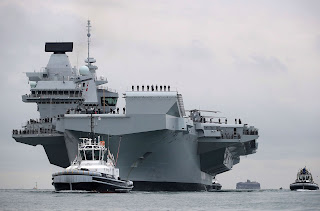HMS Queen Elizabeth is the lead ship of the Queen Elizabeth class of aircraft carriers, the largest warships ever built for the Royal Navy of the United Kingdom and capable of carrying up to 70 aircraft. She is named in honour of the first Queen Elizabeth, a World War I era super-dreadnought, which in turn was named after Queen Elizabeth I. The carrier Queen Elizabeth will carry her namesake ship's honours, as well as her Tudor rose-adorned crest and motto.
The ship began sea trials in June 2017, was commissioned on 7 December 2017 and is scheduled to enter service in 2020. Her first commanding officer was Commodore Jerry Kyd, who had previously commanded the carriers Ark Royal and Illustrious.
Queen Elizabeth has no catapults or arrestor wires, and is instead designed to operate V/STOL aircraft. The air wing will typically consist of F-35B Lightning II multirole fighters and Merlin helicopters for airborne early warning and anti-submarine warfare. The design emphasises flexibility, with accommodation for 250 Royal Marines and the ability to support them with attack helicopters and large troop transports such as Chinooks. She is the second Royal Navy vessel to bear the name Queen Elizabeth, and is based at HMNB Portsmouth.
On 25 July 2007 Defence Secretary Des Browne announced the order for two new carriers. At the time of approval the first carrier was expected to enter service in July 2015 and the budget was £4.085b for two ships. The financial crisis led to a political decision in December 2008 to slow production, delaying Queen Elizabeth until May 2016. This added £1.56 billion to the cost. By March 2010 the budget was estimated at £5.9 billion and in November 2013 the contract was renegotiated with a budget of £6.2 billion. The in-service date was further extended to 2020 in the Strategic Defence and Security Review in October 2010.
